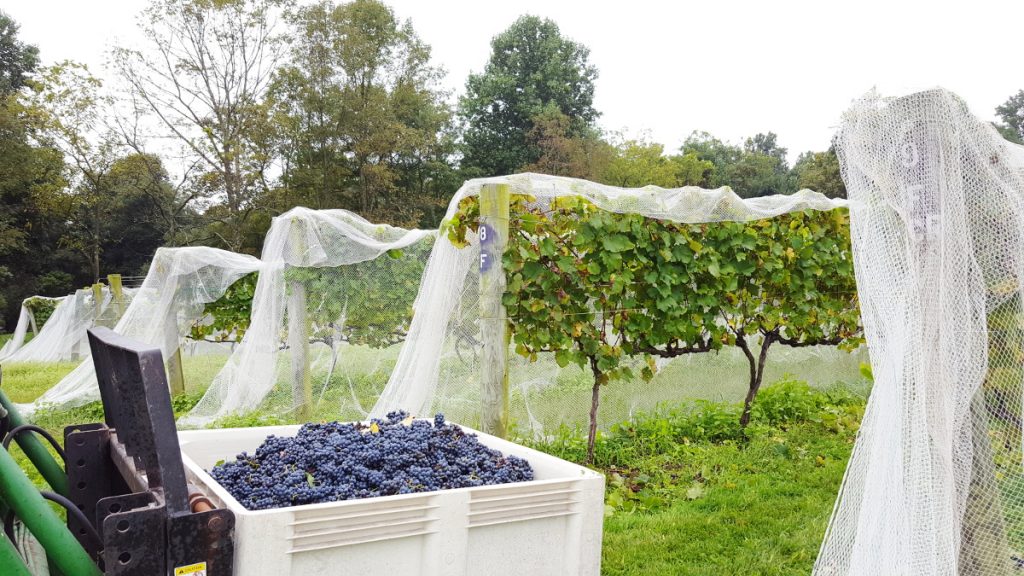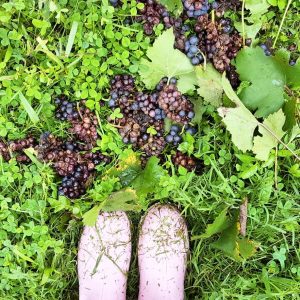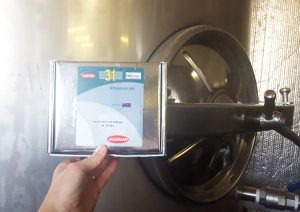When a vintage goes less than planned, it can often produce hardship in producing high quality red wine.
There are several issues that are concerning with regards to red wines:
- Lack of color intensity
- Excessive astringency or bitterness
- High acid (sourness)
- Lack of alcohol
- Incidence of green flavors, many that may smell like “green bell pepper”
Depending on the season, creating quality, fruit-driven red variety wines may difficult. Many white wine grape varieties produce decent wines, even in challenging vintages, if proper harvest and winemaking decisions are made. Late-season red wine grape varieties, on-the-other-hand, pose particular challenges as they are likely to retain high acidity, green flavors, and harsh tannins that are not viewed upon favorably by consumers.

Create a Red Winemaking Strategy for “Sour” Situations
The “off-season” is a good time to develop winemaking strategies for those “just in case” moments if the vintage starts to go south. If you’ve taken good winemaking notes during the harvest season, you can extrapolate what techniques worked well for some of your wines and which you would probably change.
In this current vintage, I saw a number of veteran winemakers refer back to notes from the 2011 and 2003 vintages, evaluating how to best handle their fruit. This gave them an advantage in terms of having a plan and intentionally producing the best quality wine that they could despite the weather.
At the end of the 2018 vintage, review your notes and lessons learned. Identify processes that worked to your advantage during the harvest. Taking time to reflect and strategize for “next time” can save time and energy that will be well needed if and when a vintage takes a turn for the worst.
I encourage my clients to take their harvest notes and develop or update general process flow diagrams for each style of wine that they produce. As a member of the DGW Community, you can find several Processing Templates to assist production decisions here.
In ideal vintages, these flow diagrams are packed with information that removes the guess work associated with harvest disorganization. However, it’s also important to create a couple of decision trees or flow diagrams for those vintages that are less than ideal.
Since most of us are wrapping up harvest, now is the time to make sure that you are taking notes on processing techniques and decisions. Include details like:
- The type of rot on fruit and the percentage of fruit affected by the rot.
- Any notes on fruit maturity, or lack of maturity. What processing steps did you take to address the immaturity issue?
- Additions or processes for juice processing, prior to fermentation. Did any of these additions provide you with results that you found positive? Or, were you less-than-satisfied with an addition? Both observations are important.
- Fermentation additions including the type of yeast strain, nutrients added, and any fermenting aids that may be appropriate for future vintages. What practices or additions would you keep the same? Which would you change?
- Maceration techniques used on red varieties. How did your decisions impact the final wine?
- Analytical data of the wine post-primary fermentation and post-malolactic fermentation. This numerical information can provide windows of information that highlight the influence of processing treatments throughout production.
Must/Juice Prep

Sorting out excessively green berries and green matter in the vineyard or by use of a sorting line should be the priority. This will help minimize sources of green matter in the fermentation vessel that can otherwise contribute to green aromas and flavors.
For red wine grape varieties that rest below an estimated alcohol of 11.0%, it may be beneficial to consider chapitalization. Depending on your wine producing region, there may be restrictions on the source of a sugar addition (i.e., concentrate vs. table sugar).
While many winemakers may opt for table sugar, the use of grape concentrates could also be an option. Concentrates likely come from another wine region, so consider your addition percentages in relation to vintage and varietal labeling. However, concentrates offer potential positive sensory benefits, acting as a source for fruit-driven flavors and ripe tannins that can influence the wine mouthfeel. For varieties that are intended as non-vintage or formulaic wines, this may be an added benefit to using concentrates over table sugar in the chapitalization process.
Wineries that have access to thermo-vinification processes may benefit in reducing green off-aromas in the must and juice. Here, the must is subjected to high temperatures prior to fermentation and then quickly cooled to avoid cooking. Primary fermentation progresses as normal.
Unfortunately, many wineries do not have access to this technology, as the cost is inhibitive. Nonetheless, thermo-vinification is not a magic bullet. Grapes that suffer from immaturity can retain green aromas in the finished wine, even if they are less intense than when the treatment is not applied. Thermo-vinification also alters the style of the wine and has recognizable sensory characteristics that may affect the wine’s style or varietal identity.
Skin Contact
Most winemaking literature directs winemakers to minimize skin contact with rotted or immature red wine grape varieties.
In theory, this practice should extract less rot or green characters. Additionally, it will minimize contact and extraction of any bitter, harsh tannins that contribute to excessive astringency or bitterness. Some winemakers will remove seeds using mesh screens during pump overs. Remember to sanitize your mesh before it comes in contact with the fruit!
Less skin contact time also means minimal color extraction and likely less intense desirable (fruity) wine aromas.
In this less-than-ideal scenario, I would recommend eliminating cold soak processes. In my opinion, the odds are not in favor of the cold soak process being beneficial. Instead, cold soaks optimize spoilage and degradation opportunities. Furthermore, it provides time to extract green off-aromas.
Minimizing skin contact time during fermentation and post-fermentation may also be helpful. This will reduce exposure to underdeveloped aromas and/or harsh tannins that contribute highly astringent or bitter wines. Again, keep in mind this practice may also decrease color intensity. However, color can be adjusted through blending or the addition of grape color (e.g., MegaPurple, Purple 8000).
Primary Fermentation
Depending on your primary objective for the wine, there are two options a winemaker may choose from during primary fermentation.
The most common suggestion is to use a quick-fermenting yeast strain that elevates fermentation temperature in an effort to “blow off” any green characters. The problem with this strategy is that it will likely blow off fruit flavors as well.
An alternative strategy involves using slow-fermenting yeast strain and controlling fermentation temperature below 80°F. Here, the objective is to retain fruitiness and drive greater potential for softer mouthfeel development by polysaccharide production.
Either scenario provides pros and cons for winemakers. There is no one correct way to optimize primary fermentation for unripe red fruit.
Regardless of yeast selection, proper nutrient management is essential to minimize the risk of stuck fermentations or hydrogen sulfide development. Measuring YAN and adjusting the nutrient content based on YAN enhances the potential for clean fermentations, avoiding additional wine flaws. You can discover more information on yeast nutritional strategies by visiting a previous blog post, Yan… to the Rescue! (Scroll down to the bottom of that article for more references and useful yeast nutrition tools.)
During primary fermentation, techniques such as délestage (rack and return) with seed removal can help reduce astringency and bitterness from unripe fruit. In traditional délestage, fermenting juice is removed from a risen cap [of grape skins] out the bottom of the fermentation tank. Once the juice is removed, the cap drains for several hours. The fermenting juice is later reapplied over the cap through a gentle pump or a cap sprinkler (irrigation) system. This process is usually conducted daily during red wine fermentation.
Dr. Bruce Zoecklein, from Virgina Tech, has previously published research on the use of délestage compared to other traditional pump-over and punch-down processes in Virginia red wines. A key advantage of this technique is that seeds can be removed and added back to the fermentation in more control concentrations to reduce astringency and bitterness of the finished wine. This may be a convenient technique in years in which seed tannins do not fully develop.
Malolactic Fermentation

Malolactic fermentation (MLF) can help decrease acidity (sourness) that may be more prevalent in unripe red fruit.
Sequential MLF after primary has completed is commonly used for making red wines. Co-inoculation (or co-fermentation) of both the yeast and malolactic bacteria is another option that winemakers can use that may be helpful in unideal years.
There is some evidence that shows co-fermentation can enhance fruity characteristics. However, the consistent advantage of this technique is reducing overall production time from harvest to the end of MLF. This erases the lag time between primary and malolactic fermentations that is considered a “high risk” time period for potential spoilage.
Both red wine Processing Templates: Primary Fermentation with Sequential MLF and Co-Fermentation outline the production steps required for integrating MLF during the red winemaking process. These flow diagrams are open to the entire DGW Community.
Post-Fermentation Processing
Green aromas can mask the natural fruitiness affiliated with any wine. These aromas may be difficult to remediate, which can ultimately affect wine quality and varietal wine character. The winemaker’s primary objective may be to minimize green aroma development as much as possible.
Red wines may have been pressed during primary fermentation to minimize skin contact. When pressing, it may be advantageous to separate press fractions. Later press fractions that involve more pressure during a press cycle may retain higher concentrations of green-aromas. Separating the fractions provides an opportunity to evaluate with sensory evaluation at a later date to confirm the quality of the wine. Different press fractions can be discarded or blended as necessary.
Following the completion of primary fermentation, rack wines off of their gross lees within 24 hours. The lees may absorb some of those green characters in the wine. This helps minimizes retention of green aromas.
Is There More You Can Do?
The short answer is yes!
The good news is, you don’t have to “give up” on vintages that provide winemaking challenges. It may not produce the best of wines, but it doesn’t have to produce garbage either.
In addition to the major processing techniques discussed above, product additions and processing aids like enzymes, tannins, and polysaccharides can all be helpful. The use of oak is another option.
Many of these wines may be optimal for future formula wines. Though I should note, I do not encourage using flawed wines for formula wines; I’m simply stating that having a more neutral red wine could provide you with a logical base product for formula wines.
The key is knowing where to apply specific production techniques, and which will optimize wine quality.
Do you Need More Help?
Knowing what decisions to make and when to make them can be overwhelming. If you need assistance in developing quality, effective production plans in your winery, contact me today (info@dgwinemaking.com) for tailored consulting options.
